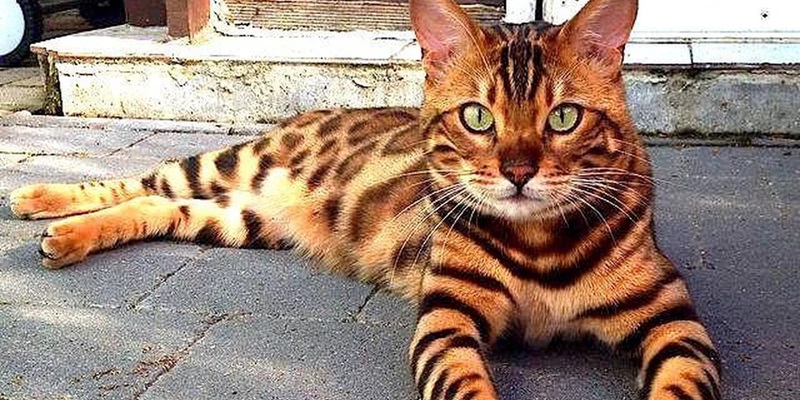What Is a Bengal Cat?
The Bengal cat is a domestic cat with the striking appearance of a wild jungle cat. It’s known for its leopard-like spots, high energy, and playful personality. But don’t let its wild look fool you—Bengals love being around people and make wonderful pets for the right homes.
This article is a complete guide to Bengal cats—where they come from, how they behave, how to care for them, and what makes them so special.
The Story Behind the Bengal Breed
A Mix of Wild and Domestic
The Bengal cat came from a unique mix of a wild Asian leopard cat and a regular domestic cat. This combination was first done by breeders in the United States in the 1960s and 70s. Jean Mill, one of the pioneers of this breed, wanted a pet that looked exotic but was friendly and safe to keep at home.
Over time, breeders worked carefully to create Bengal cats that were both beautiful and tame. Today’s Bengals are several generations removed from their wild ancestors, and they are loving companions.
How a Bengal Cat Looks
A Coat That Turns Heads
Bengal cats are best known for their eye-catching coat. They often have rosette spots, stripes, or marbled patterns, and their fur is soft, short, and glossy. Some even sparkle slightly in the light, a trait called the “glitter” effect.
Colors can vary but include shades like golden brown, snow (white or cream), and silver.
Physical Features
- Eyes: Large and expressive, often green or gold
- Ears: Rounded and alert
- Body: Muscular, sleek, and athletic
- Tail: Medium-length, thick, and often patterned with rings
Bengal Cat Personality
Curious, Clever, and Full of Energy
Bengals are smart, playful, and always on the go. They need plenty of attention and like to explore their surroundings. Some even enjoy playing in water or learning tricks—yes, you can actually train a Bengal to fetch!
They don’t enjoy being bored. If left alone for too long without toys or interaction, they may get into trouble just to entertain themselves.
Friendly but Independent
Bengals enjoy being with people but don’t always want to cuddle. They might follow you around, “talk” to you, or sit nearby, but they also like their space.
How to Care for a Bengal Cat
Feeding Your Bengal
Because Bengals are active cats, they need good-quality food with lots of protein. Choose food made for high-energy cats. You can go with dry, wet, or even raw food (after talking to your vet).
Feed them on a schedule and make sure they always have fresh water.
Grooming and Hygiene
Luckily, Bengal cats don’t need much grooming. Their short coat rarely mats or sheds heavily. Brushing them once a week will help keep their fur healthy and reduce hairballs.
They usually keep themselves clean and don’t need regular baths—unless they jump into the bathtub for fun!
Exercise and Mental Stimulation
These cats need both physical and mental challenges. A bored Bengal can become loud or destructive.
Keep them happy with:
- Climbing trees and wall shelves
- Puzzle toys
- Feather wands and laser pointers
- Playtime with you every day
Health and Life Expectancy
Health Conditions to Watch For
While Bengals are usually healthy, they can be prone to certain issues:
- Heart disease (HCM)
- Eye problems (like PRA)
- Hip issues
- Digestive trouble in rare cases
A good breeder will screen for these, and regular vet visits will help catch any problems early.
How Long They Live
Most Bengal cats live 12 to 16 years, and some live even longer with proper care.
Bengal Cats and Family Life

Are They Good for Families?
Bengals are great for active households. If you have kids who love to play or other pets who enjoy running around, your Bengal will fit right in.
Other Pets
With slow introductions, Bengals can get along with other cats and even dogs. They tend to be confident, which helps them blend in with pets that aren’t too shy or aggressive.
Bengal Cat Cost and Ownership
Price of a Bengal Kitten
A Bengal cat is a premium breed, and the price reflects that. On average, Bengal kittens cost between $1,000 and $4,000. Cats meant for shows or breeding can be even more expensive.
Monthly Expenses
Apart from the initial cost, expect to spend $60 to $100 per month on:
- Food
- Litter
- Toys
- Vet care
- Insurance (optional, but helpful)
Pros and Cons of Owning a Bengal Cat
What You’ll Love
- Gorgeous, exotic look
- Very active and playful
- Intelligent and trainable
- Friendly with people and pets
- Low shedding
Things to Keep in Mind
- Needs a lot of play and attention
- Can be loud and vocal
- Not the best lap cat
- Can be expensive to buy and maintain
- May get bored easily if not engaged
Fun Bengal Cat Facts
- Bengals can turn on faucets or play in the bathtub for fun
- Some Bengals are trained to walk on a leash
- Their coat can glitter like gold dust in sunlight
- They’re among the top 5 most expensive cat breeds
- Despite their wild look, Bengals are 100% domestic cats
Tips for New Bengal Cat Owners
- Spend time with your cat every day
- Use toys to challenge their smart brain
- Provide safe spaces to climb and jump
- Keep their food high in protein
- Don’t expect them to sit still—they love movement!
Final Thoughts
Bengal cats are not just pretty faces. They’re full of personality, intelligence, and love. If you’re ready for a pet that’s playful, energetic, and always curious, a Bengal cat could be the perfect addition to your family.
They may not suit every lifestyle, especially if you prefer a calm, quiet cat—but for active homes, Bengals bring endless joy and excitement. With the right care, love, and stimulation, a Bengal cat will be your loyal and fun-loving companion for many years.










